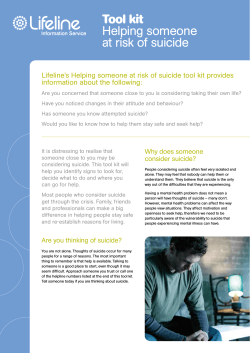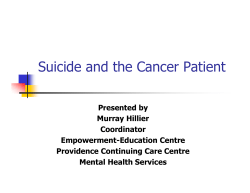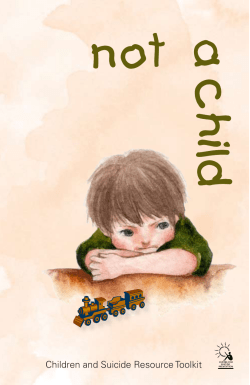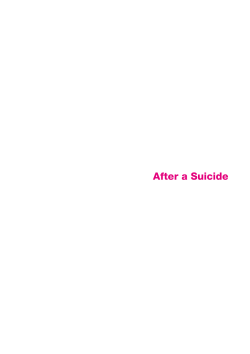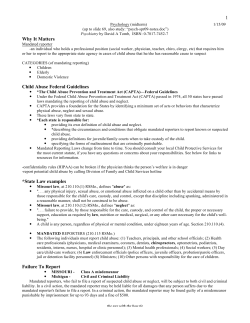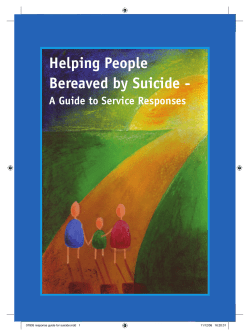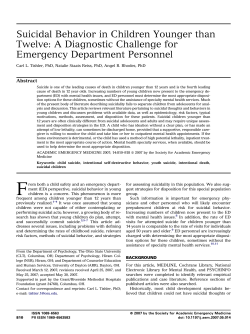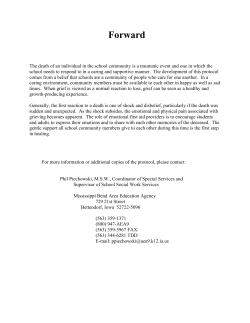
After a Suicide Attempt: A Guide for Family
After a Suicide Attempt: A Guide for Family and Friends CASP/ACPS Table of Contents AFTER A SUICIDE ATTEMPT: A GUIDE FOR FAMILY AND FRIENDS Introduction.....................................................................................................................1 Understanding Suicidal Behaviour...........................................................................2 What Happens at the Hospital Emergency Department ....................................3 Triage..........................................................................................................................3 Medical Assessment .................................................................................................3 Mental Health Assessment.......................................................................................4 Discharge Plan...........................................................................................................4 Involuntary Admission..............................................................................................5 Involuntary Assessment ...........................................................................................5 As Family or Friend, What are Your Rights and Responsibilities?.......................5 Mental Health Advocates..........................................................................................6 Support For You.............................................................................................................7 How are YOU Feeling? .............................................................................................7 How a Suicide Attempt Can Affect Your Relationship ...........................................7 How to Support Your Loved One After Their Suicide Attempt ............................8 Taking Care of Yourself ..............................................................................................11 What You Can Do to Help .........................................................................................15 Knowing When to Ask About Suicide ...................................................................15 The Warning Signs of Suicide................................................................................15 Warning Signs of Acute Risk..................................................................................16 What You Can Do When Someone is at Risk for Suicide....................................16 What You Can Say and Do to Help ........................................................................17 -i- Reducing Risk of Future Attempts ........................................................................18 • Safety Plan ............................................................................................................18 • Safety at Home .....................................................................................................19 First Time Versus Repeat Attempt.........................................................................19 Hope..........................................................................................................................20 Sample Safety Plan ..................................................................................................21 Resources.......................................................................................................................23 Publications..............................................................................................................24 On Line Resources ..................................................................................................24 References................................................................................................................25 Acknowledgements and Disclaimer........................................................................28 - ii - Introduction This guide is to help you when someone you care about has made a suicide attempt or demonstrated other suicidal behaviours. It provides: • Information on what will happen at the hospital, your loved one’s rights, and your rights. • An understanding of what is happening for someone struggling with thoughts of suicide. • Tips on how you can help and support someone who is struggling. • Ways to take care of yourself during this difficult time. • A list of resources and references. Suicidal behaviour can be very distressing for both the person at risk and those who care about them. It is important to remember that people not only get through these experiences, but that there can also be positive changes. Crises often lead to growth, increased self understanding and awareness, and the discovery of new and more effective ways of coping. In the midst of the chaos, fear and upheaval, compassion toward ourselves and those in distress gives us hope and builds resilience. Remember that there is help and you will get through this. You are not alone. This document is based on a handbook of the same name developed by Klinic Community Health Centre for use in Manitoba. Some of the descriptions as to what happens in hospital contained within this document will vary from region to region. -1- Understanding Suicidal Behaviour If they were not in great distress and were able to evaluate their options calmly and objectively, most people would not choose suicide. If they feel severely disconnected from themselves and from others, even when surrounded by caring and concerned family and friends, they may not be able to reach out for help. Unable to recognize and access their own internal resources and strengths, they lose hope that things will ever be better. If they are in great pain and suffering and can’t see a way out, they may not recognize or be able to accept the care that others are offering. There are many reasons that people attempt suicide; there is no single, simple explanation. When life seems overwhelming, when despair overcomes feelings of hope, and when life has lost meaning and purpose, a person may feel that suicide is the only way to stop and escape intolerable pain and suffering. Overwhelming loss, psychological trauma, intergenerational trauma, depression, physical and mental illness, addiction, poverty, oppression, marginalization and stigma can all contribute to suicidal behaviour. Having thoughts of suicide does not make a person bad, crazy, weak or flawed. They may not really want to die, they may have more pain than they can cope with right now. There are many kinds of suffering, including physical, mental, emotional and spiritual pain. Whether or not the pain is bearable will differ from person to person. The point at which the pain becomes unbearable depends on what kinds of coping resources a person has. It is also important to note that it is their perception or experience of an event or situation that causes the suffering or distress, not necessarily the event itself. What one person experiences as painful or overwhelming might not be the same for someone else. -2- What Happens at the Hospital Emergency Department When a person has attempted suicide, a medical assessment is the first priority. They should go to the nearest emergency department. Depending on the seriousness of the attempt, they may or may not be able to speak for themselves. Family and friends can be a valuable source of information when medical personnel are making their medical and psychological assessments. Every emergency department experience will be a little different because each hospital follows its own policies and procedures. However, there are some general guidelines of what you can expect when you are in the emergency department: Triage The triage process involves getting your loved one’s personal information as well as recording details of the attempt. It can be helpful to bring the following with you: • Manitoba Health Card. • All medications and supplements in their bottles, including prescription and over the counter. • Name of family doctor and/or psychiatrist/counsellor/mental health worker/spiritual caregiver. Medical Assessment A doctor will then assess your loved one and attend to their medical needs. This may include monitoring for a period of time to ensure their medical stability. You may want to ask the medical staff and your loved one if you can sit in on their evaluation. You may be able to provide critical information, such as: • Any access to weapons, medications, or other means of suicide. • Any changes in how medication is being taken. • Any changes in access to professional help. • Any changes in the person’s thoughts or behaviours that might indicate. a problem with their mental functioning. • If a suicide note or will has been written. • If possessions have been given away. • If abuse is occurring currently or has in the past. • Any history of past psychological trauma or traumatic events. • Significant anniversary date of a loss or an important event. • Any alcohol and/or drug use. • History of previous suicide attempts and successful aftercare or treatment. -3- • Family/friend history of suicide. • Professional supports, diagnoses and treatment plan, or lack thereof. • A health directive, if one exists. Mental Health Assessment Once the person you care about has been triaged, they may see an ER doctor and/or speak with a Psychiatric Emergency Nurse (PEN). A PEN specializes in emergency psychiatry. It is helpful to share information about your concerns in a descriptive way, i.e., “He is withdrawn, angry, drinking more for the last two weeks, pacing the house, not going to work,” etc., rather than simply saying, “He’s changed.” Any and all details are very helpful for the emergency personnel to hear because this helps them fill in the gaps and provides a more complete picture of what is going on. Your loved one will be seen and assessed, and a plan will be made for their care. At some point in the process, the ER team will need to interview your loved one alone. This is so the team can hear directly from them and get their perspective. A discharge plan may or may not include admission to hospital, being held in the ER overnight, a referral to the Crisis Stabilization Unit, or a return home. Ask what follow-up care and treatment plan is being put in place for your loved one. Follow-up is especially important because it can reduce the chance of future attempts. If you feel uncomfortable at all with the discharge plan, tell the ER team and clearly explain why you feel this way. Again, be specific: “He threatened to kill himself and told me he wouldn’t talk about it at the hospital,” rather than simply saying, “I’m worried.” Discharge Plan A good discharge or disposition plan includes some or all of the following: • Any follow-up and/or suggestions made by the assessment team. • Information about whether your loved one will be seen again, and if so, when, where and by whom. • Details of any referral made to another service, and whether the process has been explained to you. • The back-up plan, including details of who to call for help if it’s required, and where to go. • The Safety Plan. (See Safety Plan at back for more details.) • A list of local resources, including the phone numbers of local crisis lines. • The medication management plan. If medications have been prescribed, particularly in the case of overdose as method, you may be able to negotiate that they be given to you, and/or they be prescribed in a way (e.g., daily or weekly pick-up) such that the person is not being given large quantities at any given time. -4- Here are a few other things that might be helpful for you to know: • Your loved one will be seen and assessed by ER personnel, which may or may not include the psychiatry on-call team. • The ER assessment process takes time. Once immediate safety concerns have been met, you may have to wait a while, so take a book to pass the time, as well as some money for coffee, food and parking, etc. • Before you leave the hospital, make sure you and your loved one understand the discharge plan. The plan is most effective when everyone understands it. Have it in writing so you can refer to it later and be able to provide a copy to other professionals who might ask for it. • If your loved one is admitted to the hospital, ensure that you know which ward they are in and how to contact them. Involuntar y Admission Involuntary admission means the doctor is concerned enough to believe that the person you care about is at a high risk of suicide. Involuntary admission means that your loved one will be held for observation for up to 72 hours. This allows the medical personnel to make a more accurate assessment. During this time, your loved one will not be able to go out for coffee or on passes, unless it has been cleared by the doctor. If they are allowed to go out, you may be asked to accompany them and be “responsible” for getting them safely back to the unit. If you do not feel that you are up to this responsibility, you have the right to say no. You might feel more comfortable being their escort when involuntary admission has been lifted. Involuntar y Assessment If you believe that your loved one has attempted suicide or is in immediate danger of doing so, your first step always is to access emergency services (ambulance, police, or RCMP). However, sometimes the person refuses help or convinces the emergency response team that they don’t need help. You may then choose to go before a Magistrate to apply for an order that your loved one be medically examined. This is called an Application for an Order for Involuntary Medical Examination under The Mental Health Act. You do not need a lawyer for this, but the application process can be complicated. You can ask for assistance from your local Mobile Crisis Service. If you are unsure where to locate your local Magistrate, call your local Regional Health Authority or police detachment. Note that some Magistrates are available outside normal business hours. As Family or Friend, What Are Your Rights and Responsibilities? As the family member or friend (often called the natural support) of someone who attempted suicide, you may have rights to some, but not all the information about the patient. -5- In Manitoba, The Personal Health Information Act provides patients of age 16 and older with the right to access their personal health information, and the right to have that information kept private. Health care professionals may share personal health information with you if your loved one is hurt and is unable to inform you themselves, OR if the health professional believes that your loved one would not object to the information being shared. Your loved one may give you authorization to access their personal medical information on their behalf, by giving you a written, signed and dated declaration, which you would present to medical professionals providing care to your loved one. This authorization may detail what information you have access to, and what rights you can exercise on your loved one’s behalf. If you have access to personal health information and other information about your loved one, you have a responsibility to protect their privacy, and not share the information with others who are not involved in your loved one’s medical care. For example, you should not share personal health information with employers, landlords, or others without express permission of your loved one. Mental Health Advocates The Canadian Mental Health Association provides a Rights Consultation Service (RCS). This service will provide information to people who are in hospital for a psychiatric admission and who want to better understand their rights. The information the RCS in Manitoba provides is based on provincial legislation under The Mental Health Act. For example, if someone is hospitalized following a suicide attempt and needs help to understand what is going on, they can contact the RCS and ask for help in getting information about their status. Any forms that need to be completed according to The Mental Health Act about that person’s situation could also be explored with the Rights Consultant. The role of the RCS is to help people navigate the system without taking over from them. The service does not advocate for the person, but helps them advocate for themselves. They do this by providing information on rights and processes, assisting with letter writing or applications/appeals, attending meetings with the person, and deciding what makes sense for their particular situation. If someone admitted to hospital does not agree with their patient status, the RCS can also help them make an application to the Mental Health Review Board. The Board can only act on applications that are covered under legislation. The RCS can also provide information to families, friends and professionals about The Mental Health Act and the processes involved. -6- Support for You How are YOU feeling? Your emotional reactions to a suicide attempt can be intense and complicated. A suicide attempt is a traumatic event that affects everybody. You can feel overwhelmed, feel your sense of security threatened, and second-guess yourself or your ability to cope. Below is a list of common reactions to a traumatic event. If you experience some or all of these things, reach out to the medical professionals for support. • Are you on a rollercoaster of emotions that may include fear, shame, anxiety, insecurity, shock, numbness, helplessness, guilt, betrayal and/or confusion, even anger at the person who made the attempt? • Do you find normal everyday functions difficult, such as sleeping, concentrating and staying motivated? Do you feel exhausted or fatigued, or want to avoid reminders of the event or the person? Are you criticising yourself or blaming yourself for what happened? • Do your spiritual beliefs and values feel shaken? Are you feeling a temporary loss of faith? • Are you having family or work conflicts that were not there before? • Perhaps you felt so overwhelmed and tired that for a moment you thought “just do it already!” then felt a surge of guilt for having had this thought? When someone we care about attempts suicide, our reactions can be affected by past traumas and significant losses that we have experienced in our own lives. As a result, we might react to someone else’s pain, suffering and suicidal behaviour as a potential threat to our own sense of well-being, safety and security. When this happens, our nervous system automatically kicks into survival mode, preparing the body to either fight back, flee the situation, or may become immobilized and unable to respond at all. This is commonly referred to as the fight, flight or freeze response. How a Suicide Attempt Can Affect Your Relationship When someone has attempted suicide, your feelings toward them and your interactions with them may change. For example, how do you talk to them now? Do you feel awkward with them? Do you need to take more care of them, and are you more anxious and involved than usual? You might feel or act more protective, -7- cautious, careful and hyper-vigilant. Or you might find yourself avoiding the person altogether and being more distant. It is important to remember that after a suicide attempt, the relationship might also feel different for the person who made the attempt. They, too, might feel awkward and try to avoid you. Sometimes it can be helpful to tell them, in a non-judging way, how you feel. This can give you both the opportunity to decide how you will relate to and communicate with each other. Remember that it’s okay, and in fact necessary, to set limits and to let people know what those limits are. If you are clear about what your limits are, then you can more easily communicate with them in a sensitive and caring way. Tell yourself that you are not a bad person if you maintain your boundaries. Take some time and space to refuel and come back refreshed. Share with your loved ones what you can and cannot do, what you will and will not do. It may take some practice to learn when and how to set boundaries compassionately. One guideline to follow is to remember that helping someone is good, unless it leaves you feeling hurt, angry, resentful or exhausted. That’s when you can say something like, “I’d really like to help you out with that, but that’s not something I can do right now. Maybe I can help you find someone else who can, or help you figure out how to do it on your own.” How to Support Your Loved One After Their Suicide Attempt For a person to recover from one suicide attempt and to help prevent future attempts, it is important that they have a good support system and can reconnect with feelings of hope. Communication is essential to achieving this. Everyone wants to be seen, heard and understood because this helps us reconnect with ourselves, with others, and with hope. In order to help your loved one, show them compassion—be willing to hear about their suffering as an equal, with a desire to help, and without judgement. While it is ultimately your loved one’s responsibility to keep themselves safe, they may need your help and support to do so. Our ability to be compassionate is dependent on our ability to be self compassionate — to treat ourselves with kindness just as we would someone else. It is during times like this that compassion and self compassion can really be challenging. To learn more about self compassion, refer to the Mindfulness & Self Compassion resources at the end of this guide. People survive suicidal feelings if they can: • find a way to reduce the pain, and/or • find a way to increase their coping mechanisms. Both of these are possible with your help. Decide how involved you can be over the next while. Recognize your limitations, what you are comfortable with, what feels safe to you, what you have the skills to do, and what time and energy you can commit. Ensure you reach out and speak up when you need help and support. -8- There are many ways that you can support your loved one. For example: • Be involved in their medical care as a support or advocate. • Tell them they can turn to you with honest thoughts and feelings, especially if they are having thoughts of suicide again. Talking to someone about their thoughts of suicide does not increase their suicide risk; in fact, it does just the opposite and decreases risk by giving them permission to talk about what they are experiencing. So, let them know it is okay to tell you about any thoughts of suicide they might have. • Encourage them to let someone know if they have thoughts of suicide any time in the future. • Help them connect with a mental health specialist. • Be a part of their safety planning (See Safety Plan.) • Make good use of your own support system and ask for help when you need it or want it. In order to support open, honest and respectful communication, it can be helpful to ask your loved one the following questions. Ask these questions when they are feeling less intense pain, and have some ability to discuss things calmly rather than responding from a place of strong emotion. • How can I be helpful? (Ask them to be as specific as they can. They might need help with medical care, advocacy, finding resources, and connecting with resources.) • How do you want to be treated? • Can I check on you, and how often? • How safe do you feel, and how confident do you feel keeping yourself safe? • How can I intervene if you are not feeling safe? • How will I know when I should intervene? • How do you know when you are not safe? • How depressed do you feel? • What are the things that cause you to feel upset or to have thoughts of suicide? • What is helping you right now? • What helps you cope and gives you strength? • What emotions are the most difficult to cope with? • What do you find helpful and what do you find not helpful? • What are your reasons for living? It might be easier to use a rating scale of one to ten to help your loved one express their emotions and experiences and to gauge their intensity. For example, you might say, “Compared to other times you have felt depressed (or sad, lonely, insecure, hopeless, helpless, etc.), how would you rate that feeling now on a scale from one to ten?” -9- Let them know that it is okay to share with you any thoughts of suicide they might be having. It can be difficult and frightening to hear someone talk about their thoughts of suicide. If you cannot hear a loved one talk about thoughts of suicide, then have a conversation with them about whom they can talk to. You can let them know that it is hard for to you hear their pain and watch them suffer and yet you recognize that it is important that they do have someone to talk to about all that they feel and think. Encourage them to let someone know if they have thoughts of suicide at any time in the future. Another useful resource is “Coping with Suicidal Thoughts.” This document was produced by Drs. J. Samra and D. Bilsker at Simon Fraser University and is available on the Manitoba Suicide Line website, www.reasontolive.ca. - 10 - Taking Care of Yourself Caring for someone who is suicidal can be mentally, emotionally, physically and spiritually exhausting. It is natural to worry about your loved one, and it can be difficult to balance supporting them and taking care of yourself. Eventually, you may end up putting your own needs on the back burner. Do not neglect your own self care. Allow some time every day to take care of yourself. And don’t tr y to handle this situation alone. Get help from your family, friends, community and local organizations, crisis services and distress/ crisis lines. Sometimes it can help to talk about your experience with a professional who is not affected by the situation. Remember what things help you cope when you are stressed and try to do them. What healthy activities bring you comfort and help you to feel calmer and safer when things are difficult? These things may include family support, positive friends, spirituality, healthy activities, and humour. One way to care for yourself is to practice what is often referred to as mindfulness. Mindfulness means to pay purposeful attention to your feelings, thoughts, and what you are doing in the present moment in a non-judgmental way. It can help settle the body and mind during life’s many stressful moments. Mindfulness can be achieved through meditation, Qigong, yoga, or other simple and easy-to-learn stress reduction techniques. For more information, go to www.klinic.mb.ca/balance.htm or www.de-stress.ca and refer to “Calm in the Storm: Coping with the Stresses of Life.” “Mindfulness is simply being aware of what is happening right now without wishing it were different; enjoying the pleasant without holding on when it changes (which it will); being with the unpleasant without fearing it will always be this way (which it won’t).” –James Baraz Use your breathing to “anchor” you and help you become more aware of yourself in the present moment. Feel each breath as it goes in and goes out, and pause between in and out. Do not try to control your breath. Simply let it come and go. Bring in as much of your attention, as completely and continuously as you can, to the direct sensation of each breath. We help others best when we have enough energy and compassion to do so, which is why it is important that you take care of your own needs. There are many other ways to attend to your own well-being, such as going for walks, visiting friends, and taking time each day to do something that helps you feel calmer, happier and more connected with yourself and others. - 11 - What follows is a list of strategies for managing stress. 1. Accept the moment as it is: Resist the urge to blame or criticize yourself for what you think you should have done. Instead focus on the moment and what is happening now instead of what you would like to see happen or what you are worried could happen. 2. Plan ahead to remain calm: Use deep breathing as you picture yourself managing a stressful situation in a relaxed manner. 3. Be in charge of your body’s stress reactions: Learn to recognize and release tension in your body. Practice yoga, meditation and breathing techniques to calm your body and mind. Listen to relaxation CDs, guided relaxation, guided imagery, or make your own recording. 4. Eat healthful foods: Plan to keep track of what you eat for three days. Read the Canada Food Guide for healthful nutrition and decide if you want or need to make any changes to what you eat. 5. Learn stress-reduction techniques: Learn more about mindful relaxation, breathing techniques, use of imagery, and body exercises. 6. Dance, run, skip, walk: Regular exercise releases endorphins, our “feel-good” hormones. After exercising stretch your body to eliminate pent-up tension. 7. Turn on some music: Listening to music can soothe and relax you and singing can really lift your mood! The shower and car are good options for people who think their singing will cause stress for others. 8. Take up a hobby: Whether it be gardening, stamp-collecting, reading, cooking, or any physical activity, hobbies add value to your life and take you away from stresses. 9. Use humour: Lighten up a stressful situation. Watch a funny movie, read a funny book, or laugh with your friends. 10. Spend time outside: Go into the garden, stroll down a tree lined street, wander through a park, or sit under a tree. Even gazing out the window at a garden plot, looking at the stars or looking at a photo of a natural setting can reduce stress. 11. Talk to yourself: Tell yourself not to get all hot and bothered about the situation. Say to yourself “calm down, relax, let it go.” Challenge any negative thoughts that enter your mind. 12. Speak up for yourself: Allowing frustration and anger to linger is very stressful for your body. If speaking up is hard for you, think about enrolling in assertiveness training or ask a friend to help you practice. - 12 - 13. Try aroma therapy: A few whiffs of scents like lavender, rose, and green apple can help reduce tension and produce a feeling of calmness. 14. Have a hot cup of herbal tea: Chamomile or mint tea can be especially calming. 15. Let go of the idea of a perfect life: Not everything is going to work out perfectly, no matter how hard you want it to or how hard you try. 16. Make time to play: Make time everyday to do something you enjoy, something fun, something different from your daily routine. 17. Make time for friends: Organize time to spend with friends and allow time to make new ones. 18. Talk to a therapist, counsellor, or spiritual advisor: Talking therapy can help restore a feeling of control when situations are overwhelming. 19. Get in touch with your creative side: There are many ways to banish the blues through artistic expression. Try your hand at painting, drawing, making a collage, taking photos, or shaping clay. The important thing is to externalize thoughts and feelings that are causing you stress. 20. Write your thoughts and feelings in a daily journal: Journaling has many benefits such as lowering levels of stress hormones, decreasing the numbers of sick days taken, boosting the immune function, and increasing the ability to handle adversity and adjust to change. 21. Change your environment: Lower the lights, turn on calming music, and open the curtains to let the sunshine in. 22. Take a mini-break: Close your eyes and take three deep breaths while imagining yourself in a peaceful place—for example, in a garden or a field of wild flowers, or on a beach. 23. Expect change: When you accept that change is inevitable, it helps you be more flexible (and less stressed) when it does happen. 24. Take a bath: Soaking in a bath is relaxing. If the water temperature is close to your skin temperature—known as a “sedative bath,” or “neutral bath”—this is widely recognized as a great way to relieve tension. 25. Smile: Try it right now and notice any change in how you look and might feel. (Note: these strategies for managing stress were adapted from Pearson 2008.) - 13 - Self Compassion – It takes a lot of compassion to support someone who is suffering. Think about the compassion you extend to others, and remind yourself that you also deserve and need that same kind of compassion. Self compassion is the willingness to be kind to yourself instead of harshly judging your perceived failings. It can help if you recognize that we all share the conditions that lead to life’s struggles. Practice self compassion by settling your mind through mindful awareness meditation. Then add a wish for safety, well-being and happiness for yourself, other people, and finally all living beings everywhere. For more information and self compassion see “Every Person’s Guide to Self Compassion,” www.klinic.mb.ca. - 14 - What You Can Do to Help Knowing When to Ask About Suicide It may help you to recognise the warning signs of suicide and to know when to ask someone if they are having thoughts of suicide. Asking someone if they are thinking about suicide does not increase suicide risk. Rather, it decreases risk by giving them permission to talk about what they are experiencing. When you ask someone about suicide it lets them know that you are concerned, that you care, and that you want to be there for them. The Warning Signs of Suicide The phrase “IS PATH WARM” was developed by a task force of expert clinical researchers and adapted for the general public. It is an easy way to remember the warning signs of suicide. IS PATH WARM? I Ideation S Substance Abuse P Purposelessness A Anxiety T Trapped H Hopelessness W Withdrawal A Anger R Recklessness M Mood Changes - 15 - Warning Signs of Acute Risk A person in acute risk for suicidal behaviour will most often show the following warning signs: • Threatening to hurt or kill themselves, or talking of wanting to hurt or kill themselves; and/or, • Looking for ways to kill themselves by seeking access to firearms, available pills, or other means; and/or, • Talking or writing about death, dying or suicide, when this is out of the ordinary for them. These signs might only be expressed as ideas. In any case, if you see any of these signs, seek help as soon as possible by contacting a mental health professional or calling your local crisis line for a referral. What You Can Do When Someone is At Risk for Suicide Suicidal feelings are frightening for the person who is experiencing them, and for their partner, family, friends and colleagues. Anxiety and confusion about what to do and how to cope add to an already distressing situation. If you are trying to help someone who is suicidal, your first concern will be their immediate safety. Do not leave them alone while you are trying to get help. Ask another friend, family member or colleague to stay with them to ensure their immediate safety. Here are some practical and immediate things that you can do to help: ASK – when you think that someone might be thinking of suicide, ASK them as clearly and directly as you can, and as soon as possible. (source: LivingWorks) LISTEN – encourage your loved one to TALK, and be a good listener. Talking to someone who is truly listening can be very helpful for them. (source: LivingWorks) KEEP SAFE – if there is an immediate risk of suicidal behaviour, your first priority is to do something to keep them safe. This is not to the time to solve life’s problems, nor is it the time to promote secrecy. Remove anything that they could use to complete a suicide act. (source: LivingWorks) GET MEDICAL HELP – if there have been any suicidal actions, get medical help immediately by calling an ambulance or going to a hospital. At the hospital, you can be an advocate for their medical care, or you can help them be their own advocate. REASSURE THEM - let your loved one know that they WILL get through this and things can and will change. • Let them know that there ARE people out there who can help, who will not judge, and who will listen, hear and understand. - 16 - • Let them know that they are not crazy and that it is okay to have thoughts of suicide and remind them that most times when people have thoughts of suicide, they do not go through with it. Having a thought does not mean it will be put into action. • Let them know that you love them, care about them, and are concerned for them. • Let them know that even if they don’t feel it right now, there is hope, and things can and will change. • Let them know you’re very glad they are alive. • Be there with them, even if they do not want to talk. When in doubt about what you should do to help, call your local emergency services (ambulance, police, RCMP), or Mobile Crisis Service. When people get to a point of thinking about suicide, it is often because they are finding it difficult to soothe themselves and manage difficult and intense emotions. Sometimes simply being with someone who is fully present and calm will help them. You do not need to fix the problem; just quietly be with them. This is when it is important for you to practice your own self-calming techniques because when you relate to someone in a calm and accepting manner and without judging them, your calmness and acceptance can be transferred to them. What You Can Say and Do to Help Once your loved one is out of immediate danger, and if they are open to the idea, you may want to try and talk with them about what has happened. They may feel devastated, lost, ashamed, embarrassed, guilty, fearful of the future, afraid that you will withdraw your love or judge them, and even angry that emergency services were called. It is important to stay grounded by showing care, concern and compassion, and by not judging them. Here are a few examples of things you could say to comfort your loved one: • I had no idea you were in such pain. • It sounds like what you were experiencing felt intolerable and overwhelming. • I want to understand what you where experiencing/feeling. • I want to help you. Tell me what I can do to help. • I think it’s time you talk to someone about your pain. There are people who can and want to help. • You don’t have to talk if you don’t want to, but I can and want to listen. • I can’t keep this a secret. I want to help you, so we need to tell someone who can help us. • I can tell something is wrong and that you are hurting. I’m here for you. - 17 - This can be a confusing and stressful time for everyone, and it is natural to sometimes feel frustrated, angry, fearful or sad. Key things to remember are: • Be alert to warning signs, have patience, and try not to be judgmental or critical. • Be clear about and communicate your own limits and limitations. It is important that you let your loved one know what you can and cannot do, and what you will and will not do. As much as possible, do not create expectations that you may not be able to meet or fulfill. • Be sure to connect with and make use of your own support system, and to share your thoughts and feelings. Here are some things that are not helpful: • Focusing all your attention on the suicidal person to the exclusion of everyone else, including yourself. • Hovering and monitoring every action of your loved one for a long period of time. • Blaming yourself or others. • Thinking or acting like it will never happen again. • Saying judgemental things like: - How could you do this to me? - What on earth were you thinking? - Pull yourself together and snap out of it. - What’s wrong with you? - You’re just like “X” (a family member with a negative/history/story/reputation). Reducing Risk of Future Attempts Research shows that people who have attempted suicide are at greater risk to attempt suicide again. However, support and care from a strong social network can significantly reduce this risk and increase their reasons to live. Your loved one is likely to need considerable time and support from a range of people in order to manage the problems and feelings that first led to the suicide attempt. While safety is ultimately their responsibility, the following may be helpful in supporting them. Safety Plan A safety plan is a set of instructions that is followed when someone has thoughts of suicide. The plan works best if it is created when the person at risk for suicide is well and NOT in crisis. Those involved in creating the plan should involve the person at risk, their doctor, therapist, or other professional helpers, and yourself. Some elements to include in the plan are: • When the plan could be used – i.e., signs your loved one can identify that indicate a risk for suicide. - 18 - • A list of calming or comforting things that they can do. • A list or pictures of reasons for living. • A list of people to call or talk to. • A list of professionals and resources to call. • Ways to make home or work safer. • Other things to do if nothing is helping – emergency numbers, directions to the nearest hospital, what to say to emergency personnel. • Your role – e.g., how often can I check on you, how safe do you feel, when do we need to intervene. Sometimes you may notice that something is not quite right before the person does. Discuss what to do if this happens so both of you have a clear understanding of what your role is in that case. When the person is in crisis, they may tell you to ignore the plan. DON’T. Remember that it is a plan they agreed to when they were feeling well. Make sure your loved one has a card listing the phone numbers for your local 24-Hour Crisis Line. Safety at Home In order to help keep the home safe for you and your loved one: • Remove access to any means of suicide. • Keep only small quantities of alcohol, drugs or medications in the home, or none at all. • Give your loved one plenty of opportunities to talk about the attempt. • Let them know it’s okay to tell someone if they feel suicidal in the future. • Ask them if meeting with a professional would be helpful, and encourage them to follow through with this. • Offer to help them connect to supports, resources, culture and/or spiritual beliefs. • Get support for yourself – you don’t need to do this alone. • Have the safety plan in writing and in a place where it is accessible to you and your loved one. First Time versus Repeat Attempt After your loved one’s first attempt, you may feel shocked and surprised. The intensity of these and any other feelings will fade over time, and you may eventually look at life in a different way, or it may appear to go back to “normal.” Know that everyone responds differently to a suicide attempt and you are not wrong for any feelings you have. - 19 - Unfortunately, some people who attempt to end their lives have either tried in the past or will try again. Whatever has or does happen, it is NOT your fault. In anticipation of what might happen, you may likely experience feelings of exhaustion and hopelessness, and find yourself being hyper-vigilant. Remember to reach out for support and guidance and to take care of yourself. See Taking Care of Yourself information provided on pages 11-15. Hope Victor Havel wrote, “Hope is not the conviction that something will turn out well, but the certainty that something makes sense regardless of how it turns out.” As we struggle with darkness, fear, despair and apathy, we sometimes feel that there is no hope. Hope can come in many shapes and sizes. It can be as simple and profound as the voice of another human being who appears to hear our fear; the knowledge that the sun will rise tomorrow; the smell of fresh spring rain, the first snowflake in the fall, or the photo of someone we love. The source of hope is different for each and every one of us, so try to identify what hope is to you and then hold on to that. When despair seems to overcome us, we can feel disconnected from ourselves and from hope, and this can make us feel lost and isolated. What we need most in these moments is a way to reconnect and to belong. If you are struggling to maintain hope, or to help your loved one have hope, here are some questions that may help to define the meaning of hope for you and for them: • Who are the most hopeful people you have known in your life? • Who would you call to help with your hope right now? • What images or sensations do you have of hope: music, smells, objects, colours, etc.? • How do you nurture and care for your hope? What do you do to increase and strengthen it? • What most threatens your hope? • Where do you look for hope when you feel hopeless? • Can you remember a story of hope from your own life? • When you close your eyes and try to imagine a picture of hope, what do you see? • If right now a child asked you “What is hope?”, how would you respond? • Do you have a practice of hope? What if you began each day asking yourself, “What do I hope for in this day?” What if you ended each day with the reflective question, “Where did I find hope today?” Sometimes hope is too hard for your loved one to imagine, and talking about hope might be distressing for them. At these times, the best you can do is carry hope for them, and let them know you have it and will share it with them if and when they are ready. - 20 - Sample Safety Plan This is your safety plan that you helped work out for when you are having thoughts of hurting yourself. If you are now having those thoughts, start at Step 1. Go through each step until you are safe. Remember that suicidal thoughts can be very strong. It may seem they will last forever, but with support and time, these thoughts will usually pass. When they pass, you can put your energy into sorting out problems that have contributed to you feeling badly. The hopelessness you may feel now will not last forever. It is important to reach out for help and support. You can get through this difficult time. Since it can be hard to focus and think clearly when you feel suicidal, put a copy of this in a place where you can easily find and use it. 1. Do the following activities to calm/comfort myself: 2. Remind myself of my reasons for living: 3. Call a friend or family member: Phone: Name: 4. Call a backup person if the person above is not available: Name: Phone: 5. Call a care provider (psychologist, psychiatrist, therapist, mental health worker, social worker, spiritual care provider, Elder) Name: Phone: 6. Call my local crisis line: Phone: 7. Go somewhere I feel safe: 8. Go to the Emergency Room at the nearest hospital or the Crisis Response Centre Address: 9. If I don’t feel that I can get to the hospital safely, call 911 and ask for transportation to the hospital. They will send someone to transport me safely. Dr. Joti Samra, R. Psych. and Dr. Dan Bilsker, R. Psych. (lead Authors; 20070, Consortium for Organizational Mental Health (COMH; www.comh.ca), Faculty of Health Sciences, Simon Fraser University, Vancouver, B.C. This document is not intended to replace professional care with a therapist or physician. - 21 - Resources - 23 - Publications: Are you OK? A 4-Step Approach to Being Mentally Healthy – www.klinic.mb.ca Calm in the Storm: Coping with the Stresses of Life – www.klinic.mb.ca Choosing to Live: How to Defeat Suicide Through Cognitive Therapy – Thomas E. Ellis Coping with Suicidal Thoughts – www.reasontolive.ca Every Person’s Guide to Self Compassion – www.klinic.mb.ca The Mindful Path Through Depression, Williams, Teasdale, Segal and Kabat-Zinn, Guildford Press, 2007 The Mindful Path to Self Compassion – Christopher Germer, Guildford Press, 2009 Out of the Nightmare: Recovery from Depression and Suicidal Pain – David L. Conroy Self Compassion, Kristen Neff, Harper Collins, 2011 Why People Die by Suicide, Thomas Joiner, 2005 On Line Resources American Association for Suicidology – www.suicidology.org Calm In the Storm: Coping with the stresses of life – www.klinic.mb.ca/docs/booklets/CalmintheStorm.pdf Canadian Association for Suicide Prevention – www.suicideprevention.ca Center for Loss – www.centerforloss.com Centre for Suicide Prevention – www.suicideinfo.ca De-Stress Website – www.de-stress.ca Enjoy Life More – www.de-stress.ca Honoring Life Network is an Aboriginal Youth Suicide Prevention resource in English, French and Inuktitut – www.honoringlife.ca International Association for Suicide Prevention – www.iasp.info Klinic Community Health Centre – www.klinic.mb.ca Manitoba Farm & Rural Support – www.ruralsupport.ca Manitoba Suicide Line – www.reasontolive.ca Mental Health Education Resource Centre – www.mherc.mb.ca Metanoia provides information and resources addressing suicide, grief and loss – www.metanoia.org/suicide Mindful Compassion – www.mindfulcompassion.org - 24 - Mindfulness and Self Compassion Websites – www.mindful.org www.mindfulcompassion.org www.mindfulselfcompassion.org National Aboriginal Health Organization – www.naho.ca North American Two Spirit Pages – Google previous and search for information on two spirit people and suicide. The link is as follows: http://www.google.ca/url?sa=t&rct=j&q=north%20american%20two%20spirti%20page s%20&source=web&cd=3&cad=rja&ved=0CDQQFjAC&url=http%3A%2F%2Fpeople.uc algary.ca%2F~ptrembla%2Faboriginal%2Findex.htm&ei=o30-UJ3QFYOvqgGP8YG ACg&usg=AFQjCNFff_OQnj-99N2eiF51-jWQh4ujtg Suicide Awareness Voices of Education (SAVE) – www.save.org Suicide Prevention Education Awareness Knowledge (SPEAK) – www.klinic.mb.ca/speak.htm Suicide Prevention Resource Centre – www.sprc.org Trauma – www.trauma-informed.ca Turtle Island Network – www.turtleisland.org References Balachandra, A.T. (2010). Annual Review. Winnipeg: Office of the Medical Examiner, Government of Manitoba Justice Department. Bennet et al. (June 2012). After a Suicide: A Practical and Personal Guide for Survivors. Winnipeg: Klinic with the Government of Manitoba’s Youth Suicide Prevention Strategy. Bryan, Heidi (2006). After an Attempt: The Emotional Impact of Suicide Attempt on Families. Radnor, PA: Feeling Blue Suicide Prevention Council Education Support Resources for Suicide Prevention Lifeline Organization. Calgary Centre for Suicide Prevention. (2011) After a Suicide Attempt. Calgary: Centre for Suicide Prevention. Calgary Centre for Suicide Prevention. (2007) After a Suicide Attempt: Are You in Crisis? Calgary: Calgary Centre for Suicide Prevention. Canadian Mental Health Association. (2007) After a Suicide Attempt: What Next? PEI: Suicide Information. Caruso, Kevin. (January, 2012). After a Suicide Attempt; Risk is Still High for Suicide. US: www.Suicide .org Everything Addiction. (2010) After a Suicide Attempt: What Now? US: Mental Health and www.everythingaddiction.com - 25 - Government of Australia Department of Health and Ageing. (2007). Fact Sheet 9: Suicide Attempts. AU: www.livingisforeveryone.com.au Government of Manitoba (2011). Calm in the Storm: Coping with the Stresses of Life. Winnipeg: Klinic. Hill, Karen and Gorman, Janet (2008). How to Help Someone Who is Suicidal. UK: Printed by Mind Publications. Huggins, Joe (August 2009). Information and Support After a Suicide Attempt: A Department of Veterans Affairs Resource Guide for Family Members of Veterans Who are Coping with Suicidality. WA USA: Office of Mental Health Services, VA Central Office. Johnston, Judy (2006/2007). My Suicide Attempt. Toronto: Cross Currents Magazine, Vol 10, Iss. 2; pg 9. Centre for Addiction and Mental Health. Macro International (July, 2007) Final Report: Lifeline Strategies Suggested by Suicide Attempt Survivors. Suicide Prevention Lifeline Organization. Maimon, David et al. (Sept 2010). Collective Efficacy, Family Attachment, and Urban Adolescent Suicide Attempts. USA: Sage Publications for American Sociological Association. National Alliance for the Mentally Ill(NAMI) (2007). After an Attempt: A Guide to Taking Care of Your Family Member After Treatment in the Emergency Department: A Guide for Medical Professionals in the Emergency Department. US: Suicide Prevention Resource Centre and the Centre for Mental Health Services, Substance Abuse and US Department Health and Human Services. National Alliance for the Mentally Ill (NAMI) NAMI: Suicide Resource Centre, Education Development Centre Inc. (2012) Suicide: Helping Parents and Their Families After an Attempt. US: National Voice on Mental Illness and Department of Health and Human Services. PAPYRUS: Prevention of Young Suicide (2008). Not Just a “Cry for Help”. UK: Department of Children, Schools and Families. Salvation Army: Hope for Life Australia (2011).The Facts. Suicide Prevention Salvation Army Australia. SIEC #66 (2007). Men and Suicide: Part 2. Encouraging Help-Seeking and the Promise of Social Support. Calgary: Centre for Suicide Prevention. SIEC # 70 (2009). Attempted Suicide: Part 1 &2. Calgary: Centre for Suicide Prevention. Suicide Prevention and Crisis Service Organization (2012). Some Common Experiences of Suicide Survivors. US: Health Boards: Depression Message Board Blog, www.healthboards.com Suicide Prevention and Crisis Service Organization (2012). Suicide, Depression and How to Really Help, from Survivors. US: Health Boards: Depression Message Board Blog, www.healthboards.com - 26 - Suicide Prevention Information New Zealand (SPINZ) (2003) Support for Families and Whanau (Children) and Significant Others Affected by Suicide Attempt. NZ and UK: Ministry of Youth Development NZ University of Wisconsin Hospital and Clinics Authority (2011). After a Suicide Attempt. US: Department of Nursing-University of Wisconsin Health World Health Organization (2011) Suicide Prevention: Emerging From Darkness: Facts and Figures. World Health Organization: Regional Office for South-East Asia - 27 - Acknowledgements & Disclaimer The Canadian Association for Suicide Prevention would like to thank Klinic and all those who contributed to the development of this guide: Elaine Bennett, SPEAK (Suicide Prevention Education Awareness Knowledge) Advisory Committee Yvonne Bergmans, Suicide Studies Unit, St. Michael’s Hospital, Toronto, Ontario/CASP (Canadian Association for Suicide Prevention) Mary Jo Bolton, Klinic Community Health Centre Jacqueline Cassel-Vernon, Healthy Living, Seniors & Consumer Affairs Maurene Cohen, SPEAK Advisory Committee Marion Cooper, WRHA (Winnipeg Regional Health Authority) Dammy (Diana) Damstrom-Albach, Robert and Lily Lee Family Community Health Centre/CASP Mike Dillon, Klinic Community Health Centre Elliott Drewniak, Winnipeg Mobile Crisis Service Heather Forrest, Crisis Response Centre, WRHA Lori Grant, Klinic Community Health Centre Stephanie Loewen, Healthy Living, Seniors & Consumer Affairs, Province of Manitoba Enid Lyons, SPEAK Advisory Committee Nancy Parker, WRHA Lori Riedmuller, Health Sciences Centre Kathie Timmermann, Klinic Community Health Centre Jessica Todd-Burton, Klinic Community Health Centre - 28 - Tim Wall, Klinic Community Health Centre Jenn Ward, CASP Elly Van der Zande, Klinic Community Health Centre Chris Willette, Klinic Community Health Centre Lori Yusishen, Klinic Community Health Centre Disclaimer By using this handbook, you acknowledge and agree that any information contained in this handbook is provided on an “as is” basis. While every effort has been made to ensure accuracy, we do not express or imply warranties on the accuracy of the information. By using this handbook, you acknowledge that there may be errors and that such errors, once known, will only be corrected through later editions of this handbook. By using this handbook, you acknowledge that you understand and agree that the information provided is intended for general understanding and education only. This handbook is not, and is not intended to be used as, a substitute for professional medical advice, diagnosis or treatment. Always seek the advice of a physician, psychiatrist, psychologist, nurse or other qualified health care provider before you undergo any treatment or seek answers to any questions you might have. This handbook is not, and is not intended to be used as, a substitute for legal advice. Always seek the advice of a lawyer before pursuing legal action of any kind. - 29 - CASP/ACPS Canadian Association for Suicide Prevention (CASP) 870 Portage Avenue Winnipeg MB R3G 0P1 E-mail: casp@casp-acps.ca www.suicideprevention First Printing September 2012
© Copyright 2025
